2023 SUBARU BRZ engine
[x] Cancel search: enginePage 290 of 432
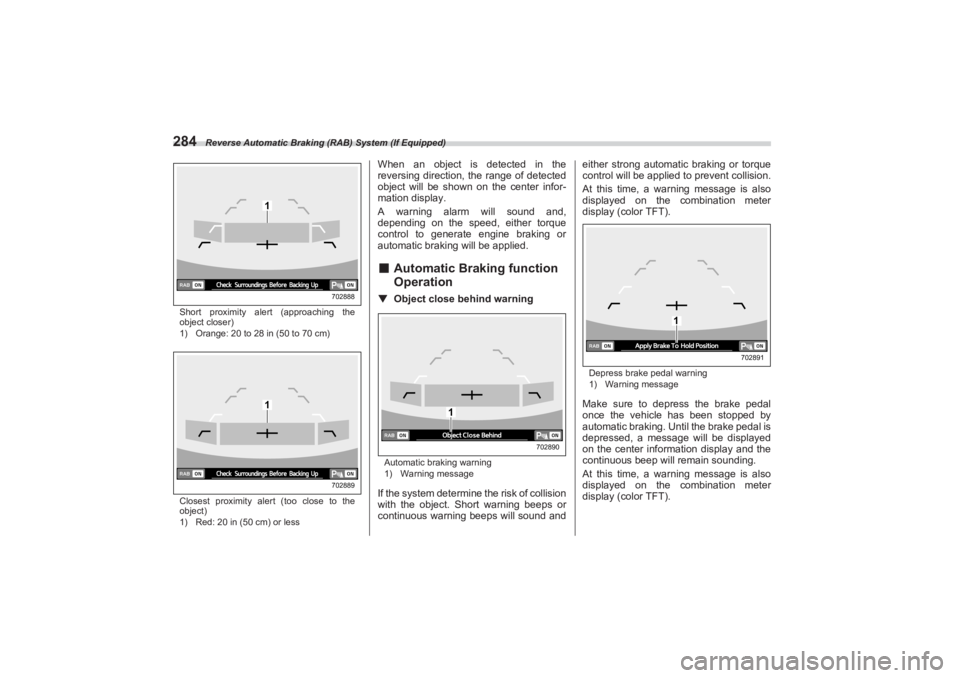
Reverse Automatic Braking (RAB) System (If Equipped)
284Short proximity alert (approaching the
object closer)
1) Orange: 20 to 28 in (50 to 70 cm)
Closest proximity alert (too close to the
object)
1) Red: 20 in (50 cm) or less
When an object is detected in the
reversing direction, the range of detected
object will be shown on the center infor-
mation display.
A warning alarm will sound and,
depending on the speed, either torque
control to generate engine braking or
automatic braking will be applied.■ Automatic Braking function
Operation▼ Object close behind warningAutomatic braking warning
1) Warning messageIf the system determine the risk of collision
with the object. Short warning beeps or
continuous warning beeps will sound and either strong automatic braking or torque
control will be applied to prevent collision.
At this time, a warning message is also
displayed on the combination meter
display (color TFT).
Depress brake pedal warning
1) Warning messageMake sure to depress the brake pedal
once the vehicle has been stopped by
automatic braking. Un til the brake pedal is
depressed, a message will be displayed
on the center information display and the
continuous beep will remain sounding.
At this time, a warning message is also
displayed on the combination meter
display (color TFT).
1
702888
1
702889
1
702890
1
702891
BRZ_U.book 284 ページ 2022年3月29日 火曜日 午後3時59分
Page 295 of 432
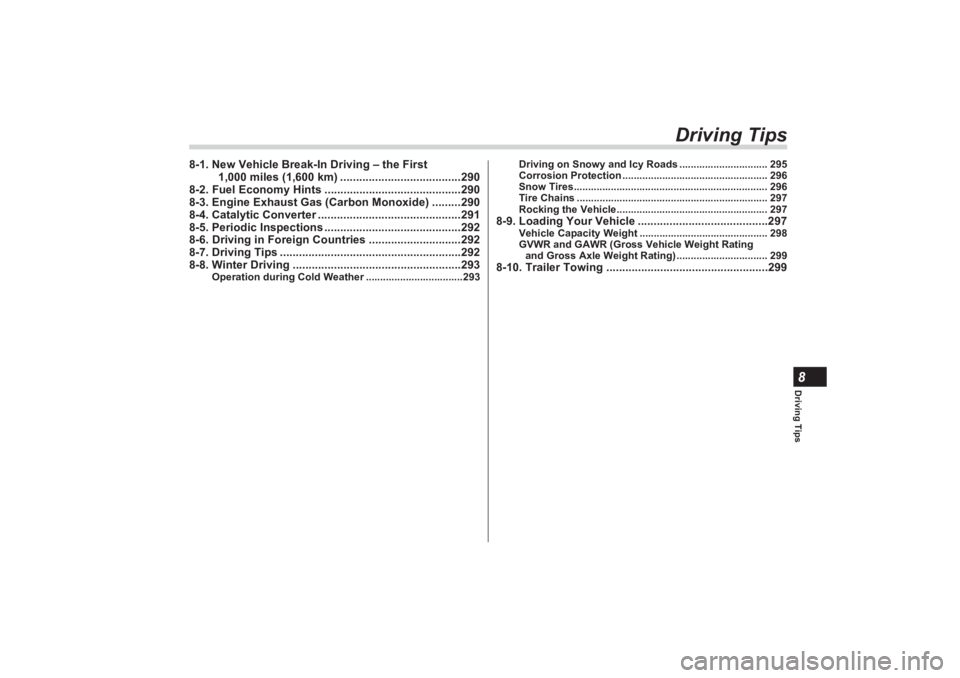
Driving Tips8
Driving Tips
8-1. New Vehicle Break-In Driving – the First
1,000 miles (1,600 km) ......................................290
8-2. Fuel Economy Hints ...................... .....................290
8-3. Engine Exhaust Gas (Carbon Monoxide) .........290
8-4. Catalytic Converter .............................................291
8-5. Periodic Inspections ...........................................292
8-6. Driving in Foreign Coun tries .............................292
8-7. Driving Tips .........................................................292
8-8. Winter Driving .....................................................293
Operation during Cold Weather ..................................293 Driving on Snowy and Icy Roads ............................... 295
Corrosion Protection ................................................... 296
Snow Tires.................................................................... 296
Tire Chains ................................................................... 297
Rocking the Vehicle..................................................... 297
8-9. Loading Your Vehicle .........................................297
Vehicle Capacity Weight ............................................. 298
GVWR and GAWR (Gross Vehicle Weight Rating
and Gross Axle Weight Rating) ................................ 299
8-10. Trailer Towing ...................................................299
BRZ_U.book 289 ページ 2022年3月29日 火曜日 午後3時59分
Page 296 of 432

New Vehicle Break-In Driving – the First 1,000 miles (1,600 km)
2908-1. New Vehicle Break-In
Driving – the First 1,000 miles (1,600 km)The performance and long life of your
vehicle are dependent on how you handle
and care for your vehicle while it is new.
Follow these instructions during the first
1,000 miles (1,600 km):
Do not race the engine. And do not
allow engine speed to exceed 4,000 rpm
except in an emergency.
Do not drive at one constant engine or
vehicle speed for a long time, either fast or
slow.
Avoid starting suddenly and rapid
acceleration, except in an emergency.
Avoid hard braking, except in an emer-
gency.
The same break-in procedures should be
applied to a newly installed or overhauled
engine or when brake pads are replaced
with new ones.
8-2. Fuel Economy HintsThe following suggestions will help to
save your fuel.
Select the proper gear position for the
speed and road conditions.
Avoid sudden acceleration or decelera-
tion. Always accelerate gently until you
reach the desired speed. Then try to main-
tain that speed for as long as possible.
Do not pump the accelerator and avoid
racing the engine.
Avoid unnecessary engine idling.
Keep the engine properly tuned.
Keep the tires inflated to the correct
pressure shown on the tire inflation pres-
sure label, which is located on the driver’s
center pillar. Low pressure will increase
tire wear and fuel consumption.
Use the air conditioner only when
necessary.
Keep the front and rear wheels in
proper alignment.
Avoid carrying unnecessary luggage or
cargo.
8-3. Engine Exhaust Gas (Carbon Monoxide)
WARNING
Never inhale engine exhaust gas.
Engine exhaust gas contains
carbon monoxide, a colorless
and odorless gas which is
dangerous, or even lethal, if
inhaled. Always properly maintain the
engine exhaust system to prevent
engine exhaust gas from entering
the vehicle. Never run the engine in a closed
space, such as a garage, except
for the brief time needed to drive
the vehicle in or out of it. Avoid remaining in a parked
vehicle for a long time while the
engine is running. If that is
unavoidable, then use the ventila-
tion fan to force fresh air into the
vehicle. Always keep the front ventilator
inlet grille free from snow, leaves
or other obstructions to ensure
that the ventilation system
always works properly.
BRZ_U.book 290 ページ 2022年3月29日 火曜日 午後3時59分
Page 297 of 432
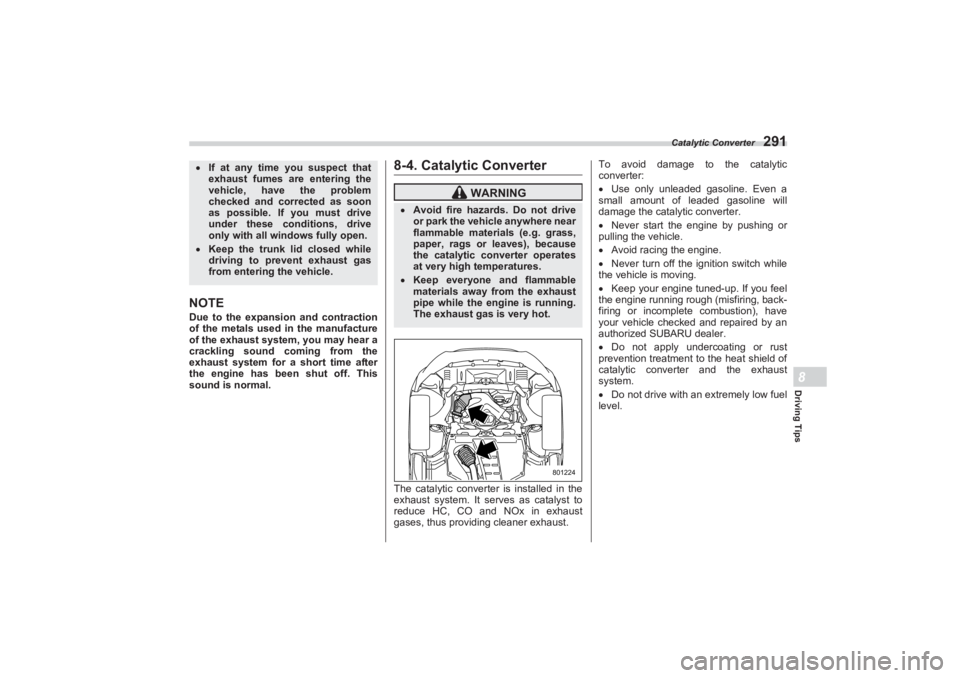
Catalytic Converter
291
Driving Tips8
NOTEDue to the expansion and contraction
of the metals used in the manufacture
of the exhaust system, you may hear a
crackling sound coming from the
exhaust system for a short time after
the engine has been shut off. This
sound is normal.
8-4. Catalytic ConverterThe catalytic converter is installed in the
exhaust system. It serves as catalyst to
reduce HC, CO and NOx in exhaust
gases, thus providing cleaner exhaust. To avoid damage to the catalytic
converter:
Use only unleaded gasoline. Even a
small amount of leaded gasoline will
damage the catalytic converter.
Never start the engine by pushing or
pulling the vehicle.
Avoid racing the engine.
Never turn off the ig nition switch while
the vehicle is moving.
Keep your engine tuned-up. If you feel
the engine running rough (misfiring, back-
firing or incomplete combustion), have
your vehicle checked and repaired by an
authorized SUBARU dealer.
Do not apply undercoating or rust
prevention treatment to the heat shield of
catalytic converter and the exhaust
system.
Do not drive with an extremely low fuel
level.
If at any time you suspect that
exhaust fumes are entering the
vehicle, have the problem
checked and corrected as soon
as possible. If you must drive
under these conditions, drive
only with all windows fully open. Keep the trunk lid closed while
driving to prevent exhaust gas
from entering the vehicle.
WARNING
Avoid fire hazards. Do not drive
or park the vehicle anywhere near
flammable materi als (e.g. grass,
paper, rags or leaves), because
the catalytic converter operates
at very high temperatures. Keep everyone and flammable
materials away from the exhaust
pipe while the engine is running.
The exhaust gas is very hot.
801224
BRZ_U.book 291 ページ 2022年3月29日 火曜日 午後3時59分
Page 299 of 432
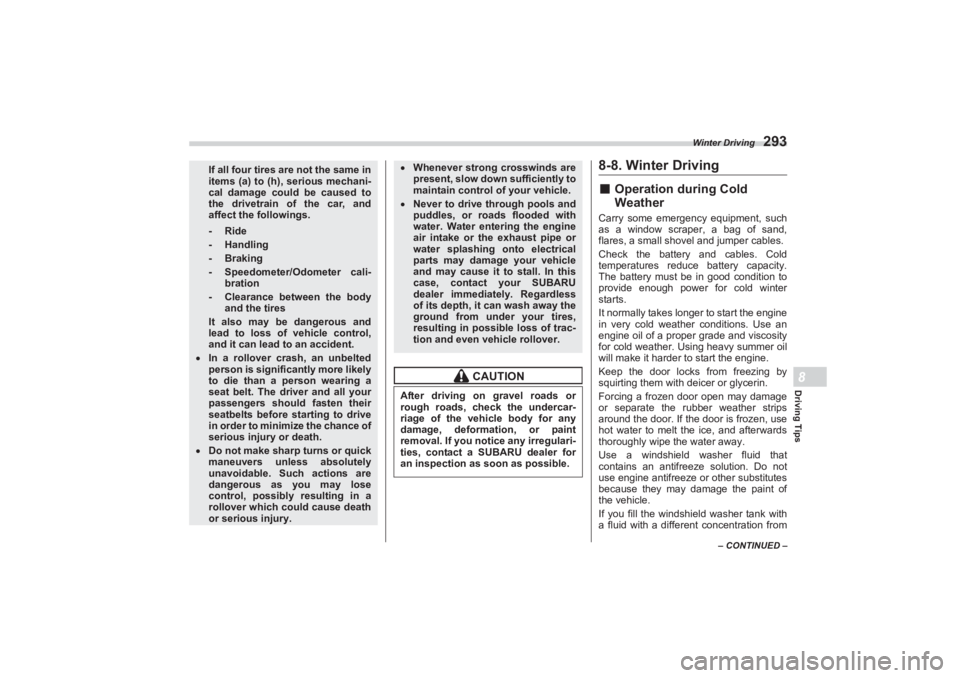
Winter Driving
293
Driving Tips8
– CONTINUED –
8-8. Winter Driving■Operation during Cold
WeatherCarry some emergency equipment, such
as a window scraper, a bag of sand,
flares, a small shovel and jumper cables.
Check the battery and cables. Cold
temperatures reduce battery capacity.
The battery must be in good condition to
provide enough power for cold winter
starts.
It normally takes longer to start the engine
in very cold weather conditions. Use an
engine oil of a proper grade and viscosity
for cold weather. Using heavy summer oil
will make it harder to start the engine.
Keep the door locks from freezing by
squirting them with deicer or glycerin.
Forcing a frozen door open may damage
or separate the rubber weather strips
around the door. If the door is frozen, use
hot water to melt the ice, and afterwards
thoroughly wipe the water away.
Use a windshield washer fluid that
contains an antifr eeze solution. Do not
use engine antifreeze or other substitutes
because they may damage the paint of
the vehicle.
If you fill the windshield washer tank with
a fluid with a different concentration from
If all four tires are not the same in
items (a) to (h), serious mechani-
cal damage could be caused to
the drivetrain of the car, and
affect the followings.-Ride-Handling- Braking- Speedometer/Odometer cali-
bration- Clearance between the body
and the tires
It also may be dangerous and
lead to loss of vehicle control,
and it can lead to an accident.
In a rollover crash, an unbelted
person is significantly more likely
to die than a person wearing a
seat belt. The driver and all your
passengers should fasten their
seatbelts before st arting to drive
in order to minimize the chance of
serious injury or death. Do not make sharp turns or quick
maneuvers unless absolutely
unavoidable. Such actions are
dangerous as you may lose
control, possibly resulting in a
rollover which could cause death
or serious injury.
Whenever strong crosswinds are
present, slow do wn sufficiently to
maintain control of your vehicle. Never to drive through pools and
puddles, or roads flooded with
water. Water entering the engine
air intake or the exhaust pipe or
water splashing onto electrical
parts may damage your vehicle
and may cause it to stall. In this
case, contact your SUBARU
dealer immediat ely. Regardless
of its depth, it can wash away the
ground from under your tires,
resulting in possible loss of trac-
tion and even vehicle rollover.
CAUTION
After driving on gravel roads or
rough roads, check the undercar-
riage of the vehicle body for any
damage, deformation, or paint
removal. If you notice any irregulari-
ties, contact a SUBARU dealer for
an inspection as soon as possible.
BRZ_U.book 293 ページ 2022年3月29日 火曜日 午後3時59分
Page 300 of 432
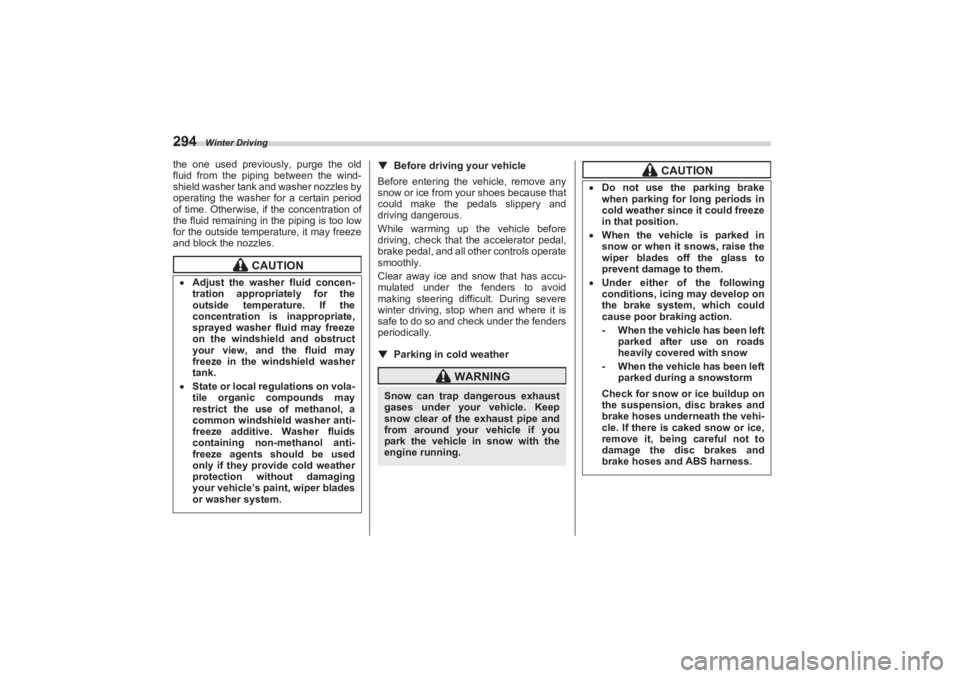
Winter Driving
294the one used previously, purge the old
fluid from the piping between the wind-
shield washer tank and washer nozzles by
operating the washer for a certain period
of time. Otherwise, if the concentration of
the fluid remaining in the piping is too low
for the outside temperature, it may freeze
and block the nozzles.
▼ Before driving your vehicle
Before entering the vehicle, remove any
snow or ice from your shoes because that
could make the pedals slippery and
driving dangerous.
While warming up the vehicle before
driving, check that the accelerator pedal,
brake pedal, and all other controls operate
smoothly.
Clear away ice and snow that has accu-
mulated under the fenders to avoid
making steering difficult. During severe
winter driving, stop when and where it is
safe to do so and check under the fenders
periodically.
▼ Parking in cold weather
CAUTION
Adjust the washer fluid concen-
tration appropriately for the
outside temperature. If the
concentration is inappropriate,
sprayed washer fluid may freeze
on the windshield and obstruct
your view, and the fluid may
freeze in the windshield washer
tank. State or local regulations on vola-
tile organic compounds may
restrict the use of methanol, a
common windshield washer anti-
freeze additive. Washer fluids
containing non-methanol anti-
freeze agents should be used
only if they provide cold weather
protection without damaging
your vehicle’s paint, wiper blades
or washer system.
WARNING
Snow can trap dangerous exhaust
gases under your vehicle. Keep
snow clear of the exhaust pipe and
from around your vehicle if you
park the vehicle in snow with the
engine running.
CAUTION
Do not use the parking brake
when parking for long periods in
cold weather since it could freeze
in that position. When the vehicle is parked in
snow or when it snows, raise the
wiper blades off the glass to
prevent damage to them. Under either of the following
conditions, icing may develop on
the brake system, which could
cause poor braking action.
- When the vehicle has been left
parked after use on roads
heavily covered with snow- When the vehicle has been left
parked during a snowstormCheck for snow or ice buildup on
the suspension, disc brakes and
brake hoses underneath the vehi-
cle. If there is caked snow or ice,
remove it, being careful not to
damage the disc brakes and
brake hoses and ABS harness.
BRZ_U.book 294 ページ 2022年3月29日 火曜日 午後3時59分
Page 301 of 432
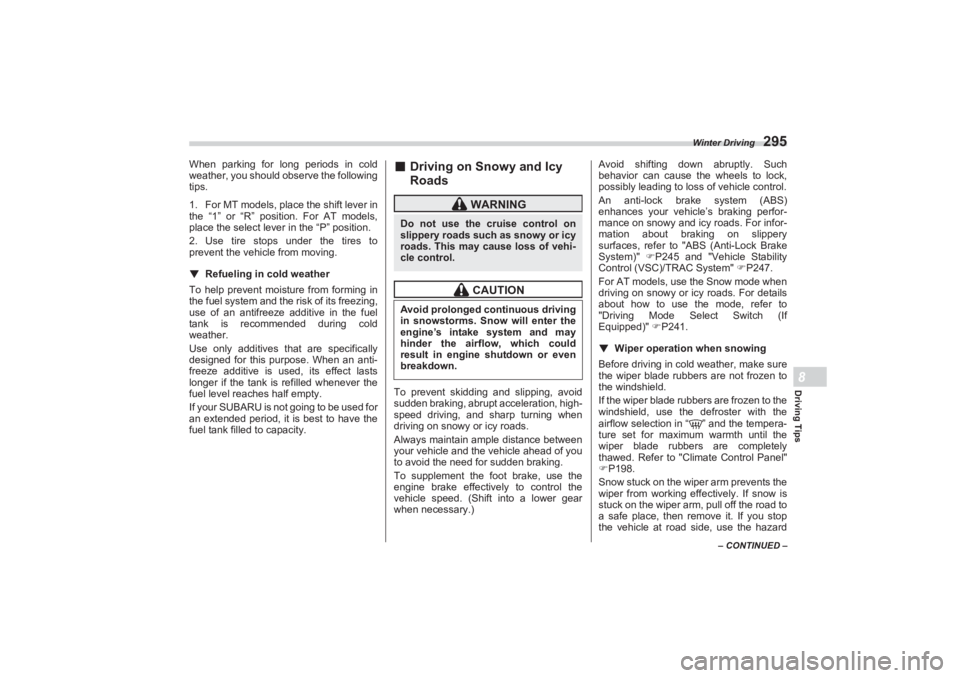
Winter Driving
295
Driving Tips8
– CONTINUED –
When parking for long periods in cold
weather, you should observe the following
tips.
1. For MT models, place the shift lever in
the “1” or “R” position. For AT models,
place the select lever in the “P” position.
2. Use tire stops under the tires to
prevent the vehicle from moving.▼ Refueling in cold weather
To help prevent moisture from forming in
the fuel system and t he risk of its freezing,
use of an antifreeze additive in the fuel
tank is recommended during cold
weather.
Use only additives that are specifically
designed for this purpose. When an anti-
freeze additive is used, its effect lasts
longer if the tank is refilled whenever the
fuel level reaches half empty.
If your SUBARU is not going to be used for
an extended period, it is best to have the
fuel tank filled to capacity.
■ Driving on Snowy and Icy
RoadsTo prevent skidding and slipping, avoid
sudden braking, abrupt acceleration, high-
speed driving, and sharp turning when
driving on snowy or icy roads.
Always maintain ample distance between
your vehicle and the vehicle ahead of you
to avoid the need for sudden braking.
To supplement the foot brake, use the
engine brake effectively to control the
vehicle speed. (Shift into a lower gear
when necessary.) Avoid shifting down abruptly. Such
behavior can cause the wheels to lock,
possibly leading to loss of vehicle control.
An anti-lock brake system (ABS)
enhances your vehicle’s braking perfor-
mance on snowy and icy roads. For infor-
mation about braking on slippery
surfaces, refer to "ABS (Anti-Lock Brake
System)" P245 and "Vehicle Stability
Control (VSC)/TRAC System" P247.
For AT models, use the Snow mode when
driving on snowy or icy roads. For details
about how to use the mode, refer to
"Driving Mode Select Switch (If
Equipped)" P241.
▼ Wiper operation when snowing
Before driving in cold weather, make sure
the wiper blade rubbers are not frozen to
the windshield.
If the wiper blade rubbers are frozen to the
windshield, use the defroster with the
airflow selection in “ ” and the tempera-
ture set for maximum warmth until the
wiper blade rubbers are completely
thawed. Refer to "Cli mate Control Panel"
P198.
Snow stuck on the wiper arm prevents the
wiper from working effectively. If snow is
stuck on the wiper arm, pull off the road to
a safe place, then remove it. If you stop
the vehicle at road side, use the hazard
WARNING
Do not use the cruise control on
slippery roads such as snowy or icy
roads. This may cause loss of vehi-
cle control.
CAUTION
Avoid prolonged continuous driving
in snowstorms. Snow will enter the
engine’s intake system and may
hinder the airflow, which could
result in engine shutdown or even
breakdown.
BRZ_U.book 295 ページ 2022年3月29日 火曜日 午後3時59分
Page 303 of 432

Loading Your Vehicle
297
Driving Tips8
– CONTINUED –
Remember to drive with care at all times
regardless of the type of tires on your
vehicle.■ Tire Chains
NOTEWhen tire chains cannot be used, use
of another type of traction device
(such as spring chains) may be
acceptable if use on your vehicle is
recommended by the device manufac-
turer, taking into account tire size and
road conditions. Follow the device
manufacturer’s instructions, espe-
cially regarding maximum vehicle
speed.
To help avoid damage to your vehicle,
drive slowly, readjust or remove the
device if it is contacting your vehicle,
and do not spin your wheels. Damage
caused to your vehicle by use of a
traction device is not covered under
warranty.
Make certain that any traction device
you use is an SAE class S device, and use it on the rear wheels only. Always
use the utmost care when driving with
a traction device. Overconfidence
because you are using a traction
device could easily lead to a serious
accident.
■ Rocking the VehicleIf you must rock the v ehicle to free it from
snow, sand, or mud, depress the acceler-
ator pedal slightly and move the shift
lever/select lever back and forth between
“1” (MT model)/“D” (AT model) and “R”
repeatedly. Do not race the engine. For
the best possible traction, avoid spinning
the wheels when trying to free the vehicle.
When the road surface is extremely slip-
pery, you can obtain better traction by
starting the vehicle with the transmission
in 2nd than in 1st (MT models).
If your vehicle is a AT model, Snow mode
can be used. For details about how to use
the mode, refer to "Driving Mode Select
Switch (If Equipped)" P241.
8-9. Loading Your Vehicle
CAUTION
Tire chains cannot be used on your
vehicle because of the lack of clear-
ance between the tires and vehicle
body.
WARNING
Never allow passengers to ride on a
folded rear seatback or in the trunk.
Doing so may result in serious
injury.
WARNING
Never stack luggage or other
cargo higher than the top of the
seatback because it could tumble
forward and injure passengers in
the event of a sudden stop or
accident. Keep luggage or cargo
low, as close to the floor as
possible.
100094
BRZ_U.book 297 ページ 2022年3月29日 火曜日 午後3時59分